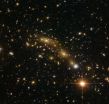(Press-News.org) Astronomers using the NASA/ESA Hubble Space Telescope have mapped the mass within a galaxy cluster more precisely than ever before. Created using observations from Hubble's Frontier Fields observing programme, the map shows the amount and distribution of mass within MCS J0416.1-2403, a massive galaxy cluster found to be 160 trillion times the mass of the Sun. The detail in this mass map was made possible thanks to the unprecedented depth of data provided by new Hubble observations, and the cosmic phenomenon known as strong gravitational lensing.
Measuring the amount and distribution of mass within distant objects in the Universe can be very difficult. A trick often used by astronomers is to explore the contents of large clusters of galaxies by studying the gravitational effects they have on the light from very distant objects beyond them. This is one of the main goals of Hubble's Frontier Fields, an ambitious observing programme scanning six different galaxy clusters -- including MCS J0416.1-2403, the cluster shown in this stunning new image [1].
Large clumps of mass in the Universe warp and distort the space-time around them. Acting like lenses, they appear to magnify and bend light that travels through them from more distant objects [2].
Despite their large masses, the effect of galaxy clusters on their surroundings is usually quite minimal. For the most part they cause what is known as weak lensing, making even more distant sources appear as only slightly more elliptical or smeared across the sky. However, when the cluster is large and dense enough and the alignment of cluster and distant object is just right, the effects can be more dramatic. The images of normal galaxies can be transformed into rings and sweeping arcs of light, even appearing several times within the same image. This effect is known as strong lensing, and it is this phenomenon, seen around the six galaxy clusters targeted by the Frontier Fields programme, that has been used to map the mass distribution of MCS J0416.1-2403, using the new Hubble data.
"The depth of the data lets us see very faint objects and has allowed us to identify more strongly lensed galaxies than ever before," explains Mathilde Jauzac of Durham University, UK, and Astrophysics & Cosmology Research Unit, South Africa, lead author of the new Frontier Fields paper. "Even though strong lensing magnifies the background galaxies they are still very far away and very faint. The depth of these data means that we can identify incredibly distant background galaxies. We now know of more than four times as many strongly lensed galaxies in the cluster than we did before."
Using Hubble's Advanced Camera for Surveys, the astronomers identified 51 new multiply imaged galaxies around the cluster, quadrupling the number found in previous surveys and bringing the grand total of lensed galaxies to 68. Because these galaxies are seen several times this equates to almost 200 individual strongly lensed images which can be seen across the frame. This effect has allowed Jauzac and her colleagues to calculate the distribution of visible and dark matter in the cluster and produce a highly constrained map of its mass [3].
"Although we've known how to map the mass of a cluster using strong lensing for more than twenty years, it's taken a long time to get telescopes that can make sufficiently deep and sharp observations, and for our models to become sophisticated enough for us to map, in such unprecedented detail, a system as complicated as MCS J0416.1-2403," says team member Jean-Paul Kneib.
By studying 57 of the most reliably and clearly lensed galaxies, the astronomers modelled the mass of both normal and dark matter within MCS J0416.1-2403. "Our map is twice as good as any previous models of this cluster!" adds Jauzac.
The total mass within MCS J0416.1-2403 -- modelled to be over 650 000 light- years across -- was found to be 160 trillion times the mass of the Sun. This measurement is several times more precise than any other cluster map, and is the most precise ever produced [4]. By precisely pinpointing where the mass resides within clusters like this one, the astronomers are also measuring the warping of space-time with high precision.
"Frontier Fields' observations and gravitational lensing techniques have opened up a way to very precisely characterise distant objects -- in this case a cluster so far away that its light has taken four and a half billion years to reach us," adds Jean-Paul Kneib. "But, we will not stop here. To get a full picture of the mass we need to include weak lensing measurements too. Whilst it can only give a rough estimate of the inner core mass of a cluster, weak lensing provides valuable information about the mass surrounding the cluster core."
The team will continue to study the cluster using ultra-deep Hubble imaging and detailed strong and weak lensing information to map the outer regions of the cluster as well as its inner core, and will thus be able to detect substructures in the cluster's surroundings. They will also take advantage of X-ray measurements of hot gas and spectroscopic redshifts to map the contents of the cluster, evaluating the respective contribution of dark matter, gas and stars [5].
Combining these sources of data will further enhance the detail of this mass distribution map, showing it in 3D and including the relative velocities of the galaxies within it. This paves the way to understanding the history and evolution of this galaxy cluster.
INFORMATION:
The results of the study will be published online (mnras.oxfordjournals.org/lookup/doi/10.1093/mnras/stu) in Monthly Notices of the Royal Astronomical Society on 24 July 2014.
Notes
[1] The cluster is also known as MACS J0416.1-2403.
[2] The warping of space-time by large objects in the Universe was one of the predictions of Albert Einstein's theory of general relativity.
[3] Gravitational lensing is one of the few methods astronomers have to find out about dark matter. Dark matter, which makes up around three quarters of all matter in the Universe, cannot be seen directly as it does not emit or reflect any light, and can pass through other matter without friction (it is collisionless). It interacts only by gravity, and its presence must be deduced from its gravitational effects.
[4] The uncertainty on the measurement is only around 0.5%, or 1 trillion times the mass of the sun. This may not seem precise but it is for a measurement such as this.
[5] NASA's Chandra X-ray Observatory was used to obtain X-ray measurements of hot gas in the cluster and ground based observatories provide the data needed to measure spectroscopic redshifts.
Notes for editors
The Hubble Space Telescope is a project of international cooperation between ESA and NASA.
The international team of astronomers in this study consists of M. Jauzac (Durham University, UK and Astrophysics & Cosmology Research Unit, South Africa); B. Clement (University of Arizona, USA); M. Limousin (Laboratoire d'Astrophysique de Marseille, France and University of Copenhagen, Denmark); J. Richard (Universite Lyon, France); E. Jullo (Laboratoire d'Astrophysique de Marseille, France); H. Ebeling (University of Hawaii, USA); H. Atek (Ecole Polytechnique Federale de Lausanne, Switzerland); J.-P. Kneib (Ecole Polytechnique Federale de Lausanne, Switzerland and Laboratoire d'Astrophysique de Marseille, France); K. Knowles (University of KwaZulu- Natal, South Africa); P. Natarajan (Yale University, USA); D. Eckert (University of Geneva, Switzerland); E. Egami (University of Arizona, USA); R. Massey (Durham University, UK); and M. Rexroth (Ecole Polytechnique Federale de Lausanne, Switzerland).
More information
Image credit: ESA/Hubble, NASA, HST Frontier Fields
Acknowledgement: Mathilde Jauzac (Durham University, UK and Astrophysics & Cosmology Research Unit, South Africa) and Jean-Paul Kneib (École Polytechnique Federale de Lausanne, Switzerland)
Links
* Images of Hubble - http://www.spacetelescope.org/images/archive/category/spacecraft/
* Paper in Monthly Notices of the Royal Astronomical Society - http://mnras.oxfordjournals.org/lookup/doi/10.1093/mnras/stu1355
* Science paper - http://www.spacetelescope.org/static/archives/releases/science_papers/heic1416a.pdf
Contacts
Mathilde Jauzac
Durham University, Institute for Computational Cosmology
Durham, United Kingdom
Tel: +33 6 52 67 15 39 (France)
Cell: +44 7445 218614 (UK)
Email: mathilde.jauzac@dur.ac.uk
Jean-Paul Kneib
École Polytechnique Fédérale de Lausanne, Observatoire de Sauverny
Versoix, Switzerland
Tel: +41 22 3792473
Cell: +33 695 795 392
Email: jean-paul.kneib@epfl.ch
Eric Jullo
Laboratoire d'Astrophysique de Marseille
Marseille, France
Tel: +33 4 91 05 5951
Email: eric.jullo@lam.fr
Johan Richard
Centre de Recherche Astronomique de Lyon, Observatoire de Lyon
Lyon, France
Tel: +33 478 868 378
Email: johan.richard@univ-lyon1.fr
Georgia Bladon
ESA/Hubble, Public Information Officer
Garching bei München, Germany
Tel: +44 7816291261
Email: gbladon@partner.eso.org
New mass map of a distant galaxy cluster is the most precise yet
Stunning new observations from Frontier Fields
2014-07-24
ELSE PRESS RELEASES FROM THIS DATE:
University of Delaware researcher describes new approach for creating organic zeolites
2014-07-24
Yushan Yan, Distinguished Professor of Engineering at the University of Delaware, is known worldwide for using nanomaterials to solve problems in energy engineering, environmental sustainability and electronics.
His early academic work focused on zeolites, porous rock with a well-defined, crystalline structure. At the atomic scale, their pore size is so precisely decided that zeolites can separate molecules with size differences of merely a fraction of an angstrom (one-tenth of a nanometer), making them useful to the chemical and petroleum industries as molecular sieves ...
Background TV can be bad for kids
2014-07-24
Parents, turn off the television when your children are with you. And when you do let them watch, make sure the programs stimulate their interest in learning.
That's the advice arising from University of Iowa researchers who examined the impact of television and parenting on children's social and emotional development. The researchers found that background television—when the TV is on in a room where a child is doing something other than watching—can divert a child's attention from play and learning. It also found that non-educational programs can negatively affect children's ...
Wireless home automation systems reveal more than you would think about user behavior
2014-07-24
This news release is available in German.
Home automation systems that control domestic lighting, heating, window blinds or door locks offer opportunities for third parties to intrude on the privacy of the inhabitants and gain considerable insight into their behavioral patterns. This is the conclusion reached by IT security expert Christoph Sorge and his research team at Saarland University. Even data transmitted from encrypted systems can provide information useful to potential burglars. Professor Sorge, who holds the juris Professorship in Legal Informatics ...
Natural products from plants protect skin during cancer radiotherapy
2014-07-24
Radiotherapy for cancer involves exposing the patient or their tumor more directly to ionizing radiation, such as gamma rays or X-rays. The radiation damages the cancer cells irreparably. Unfortunately, such radiation is also harmful to healthy tissue, particularly the skin over the site of the tumor, which is then at risk of hair loss, dermatological problems and even skin cancer. As such finding ways to protect the overlying skin are keenly sought.
Writing in the International Journal of Low Radiation, Faruck Lukmanul Hakkim of the University of Nizwa, Oman and Nagasaki ...
Identified a key molecule in flies that adjusts energy use under starvation conditions
2014-07-24
Most scientific literature devoted to the protein p53 refers to cancer biology, and the functions of this molecule as a tumour suppressor have been described in detail. Furthermore, also in cancer biology, it is known that p53 inhibits the metabolic pathways of tumour cells in order to block their metabolism and prevent their rapid growth and proliferation.
The most innovative research on p53 attempts to unveil its functions in the management of energy stores and nutrients in healthy cells. Recent studies with cell cultures have demonstrated that p53 is activated in response ...
Metastatic brain tumor treatment could be on the horizon with use of SapC-DOPS
2014-07-24
CINCINNATI -- Over half of patients being seen in the clinic for a diagnosed brain tumor have metastatic cancer, which has no treatment and detrimental outcomes in most cases.
However, a Cincinnati Cancer Center (CCC) study, published in the advance online edition of the journal Oncotarget, provides hope that previously studied SapC-DOPS could be used for treatment of brain cancer that has spread.
Xiaoyang Qi, PhD, member of the CCC, associate director and associate professor in the division of hematology oncology at the University of Cincinnati (UC) College of Medicine ...
Seeing the same GP at every visit will reduce emergency department attendance
2014-07-24
Attendances at emergency departments can be reduced by enabling patients to see the same GP every time they visit their doctor's surgery. This is just one of several recommendations made in a report published today, led by researchers at the University of Bristol.
Called 'Primary care factors and unscheduled secondary care: a series of systematic reviews', the report has been compiled by researchers from the University's Centre for Academic Primary Care who looked at evidence from studies around the world. They found that patients who saw the same GP every time they attended ...
New research: When it hurts to think we were made for each other
2014-07-24
Toronto - Aristotle said, "Love is composed of a single soul inhabiting two bodies." Poetic as it is, thinking that you and your partner were made in heaven for each other can hurt your relationship, says a new study.
Psychologists observe that people talk and think about love in apparently limitless ways but underlying such diversity are some common themes that frame how we think about relationships. For example, one popular frame considers love as perfect unity ("made for each other," "she's my other half"); in another frame, love is a journey ("look how far we've ...
Four billion-year-old chemistry in cells today
2014-07-24
Parts of the primordial soup in which life arose have been maintained in our cells today according to scientists at the University of East Anglia.
Research published today in the Journal of Biological Chemistry reveals how cells in plants, yeast and very likely also in animals still perform ancient reactions thought to have been responsible for the origin of life – some four billion years ago.
The primordial soup theory suggests that life began in a pond or ocean as a result of the combination of metals, gases from the atmosphere and some form of energy, such as a lightning ...
Western Indian Ocean communities play vital role in conservation
2014-07-24
An international team of researchers led by the University of York has carried out the first assessment of community-led marine conservation in the Western Indian Ocean.
The results, reported in the journal PLOS ONE, point to a revolution in the management of marine protected areas, with almost half of the sites – more than 11,000 km² – in the region now under local community stewardship.
Marine protected areas (MPAs) are zones of the seas and coasts designed to protect wildlife from damage and disturbance and managed typically by governments rather than by local communities. ...
LAST 30 PRESS RELEASES:
Baby sharks prefer being closer to shore, show scientists
UBC research helps migrating salmon survive mortality hot-spot
Technical Trials for Easing the (Cosmological) Tension
Mapping plant functional diversity from space: HKU ecologists revolutionize ecosystem monitoring with novel field-satellite integration
Lightweight and flexible yet strong? Versatile fibers with dramatically improved energy storage capacity
3 ways to improve diabetes care through telehealth
A flexible and efficient DC power converter for sustainable-energy microgrids
Key protein regulates immune response to viruses in mammal cells
Development of organic semiconductors featuring ultrafast electrons
Cancer is a disease of aging, but studies of older adults sorely lacking
Dietary treatment more effective than medicines in IBS
Silent flight edges closer to take off, according to new research
Why can zebrafish regenerate damaged heart tissue, while other fish species cannot?
Keck School of Medicine of USC orthopaedic surgery chair elected as 2024 AAAS fellow
Returning rare earth element production to the United States
University of Houston Professor Kaushik Rajashekara elected International Fellow of the Engineering Academy of Japan
Solving antibiotic and pesticide resistance with infectious worms
Three ORNL scientists elected AAAS Fellows
Rice bioengineers win $1.4 million ARPA-H grant for osteoarthritis research
COVID-19 booster immunity lasts much longer than primary series alone, York University-led study shows
Bentham Science joins United2Act
When thoughts flow in one direction
Scientists identify airway cells that sense aspirated water and acid reflux
China’s major cities show considerable subsidence from human activities
Drugs of abuse alter neuronal signaling to reprioritize use over innate needs
Mess is best: disordered structure of battery-like devices improves performance
Skyrmions move at record speeds: a step towards the computing of the future
A third of China’s urban population at risk of city sinking, new satellite data shows
International experts issue renewed call for Global Plastics Treaty to be grounded in robust science
Novel material supercharges innovation in electrostatic energy storage
[Press-News.org] New mass map of a distant galaxy cluster is the most precise yetStunning new observations from Frontier Fields





